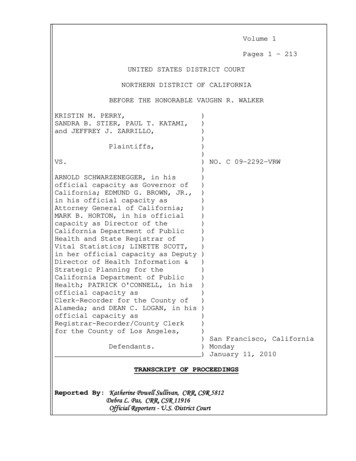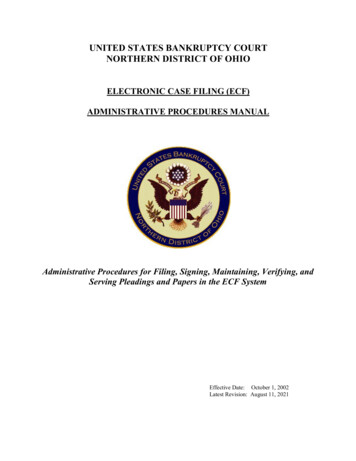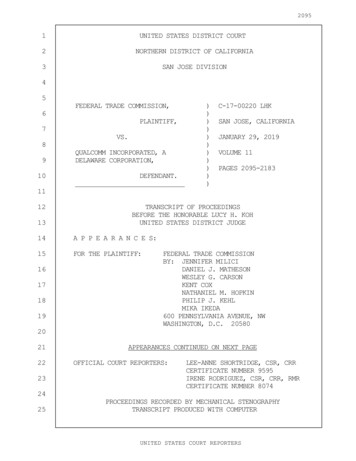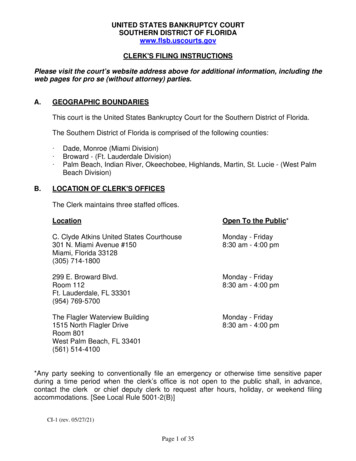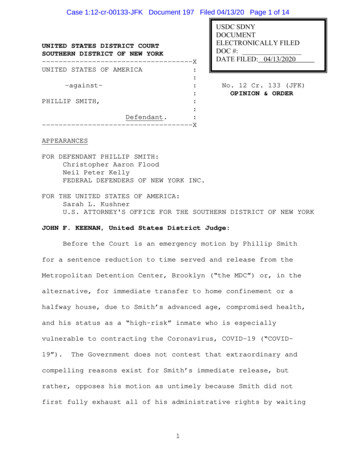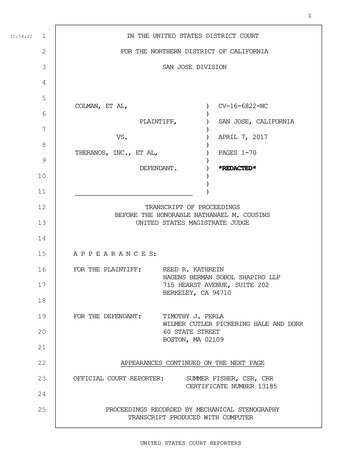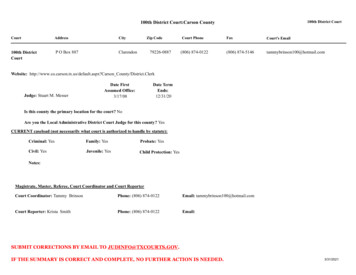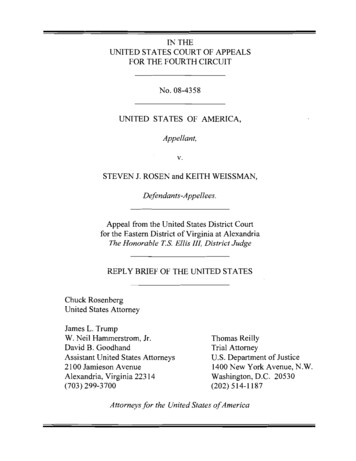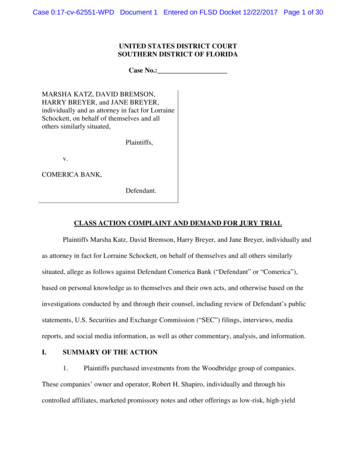
Transcription
Case 0:17-cv-62551-WPD Document 1 Entered on FLSD Docket 12/22/2017 Page 1 of 30UNITED STATES DISTRICT COURTSOUTHERN DISTRICT OF FLORIDACase No.:MARSHA KATZ, DAVID BREMSON,HARRY BREYER, and JANE BREYER,individually and as attorney in fact for LorraineSchockett, on behalf of themselves and allothers similarly situated,Plaintiffs,v.COMERICA BANK,Defendant.CLASS ACTION COMPLAINT AND DEMAND FOR JURY TRIALPlaintiffs Marsha Katz, David Bremson, Harry Breyer, and Jane Breyer, individually andas attorney in fact for Lorraine Schockett, on behalf of themselves and all others similarlysituated, allege as follows against Defendant Comerica Bank (“Defendant” or “Comerica”),based on personal knowledge as to themselves and their own acts, and otherwise based on theinvestigations conducted by and through their counsel, including review of Defendant’s publicstatements, U.S. Securities and Exchange Commission (“SEC”) filings, interviews, mediareports, and social media information, as well as other commentary, analysis, and information.I.SUMMARY OF THE ACTION1.Plaintiffs purchased investments from the Woodbridge group of companies.These companies’ owner and operator, Robert H. Shapiro, individually and through hiscontrolled affiliates, marketed promissory notes and other offerings as low-risk, high-yield
Case 0:17-cv-62551-WPD Document 1 Entered on FLSD Docket 12/22/2017 Page 2 of 30investments backed by high-interest real-estate loans to third-party commercial borrowers. But,in reality, Woodbridge had few real counterparties. Nearly all of the allegedly supporting loanswere to Shapiro’s own shell companies. Lacking the revenue to pay returns owed to Plaintiffsand other investors, Shapiro paid the returns using new investor money, raising more than 1.22billion before the Ponzi scheme collapsed. In December 2017, most of the Woodbridgecompanies declared Chapter 11 bankruptcy. The investors now confront enormous losses. TheSEC, while not seeking restitution for investors, named Shapiro and his Woodbridge entities asdefendants in a complaint filed in this District on December 20, 2017.2.Comerica had notice of Shapiro’s fraud from a series of red flags associated withthe accounts from which Shapiro misappropriated over 21 million in investor funds. EachWoodbridge bank account was opened and maintained at Comerica, and Comerica continued toenable Shapiro’s fraud even after several state regulatory agencies ordered him to cease anddesist operations. Woodbridge lacked internal controls and engaged in many atypical bankingactivities. Drawing on Woodbridge’s Comerica accounts, Shapiro spent millions of dollars onprivate planes, expensive cars, jewelry, and other luxury goods. Shapiro’s wife, and his wife’scompany, also received substantial investor proceeds from Woodbridge’s accounts at Comerica.Although Woodbridge was a billion-dollar enterprise, Shapiro remained the sole signatory on allof its accounts and insisted on hand-signing every check to investors and sales agents.Woodbridge and Shapiro used 368 million in new investor funds to pay existing investors outof Comerica accounts. Shapiro pooled investment funds from promissory note holders andpurchasers of his other fraudulent offerings in fund entity accounts, further commingling thosefunds into a single Woodbridge operating account under his control. The commingling involvedtransfers of around 1.66 billion and nearly 11,000 Comerica account transactions. Raising yet2
Case 0:17-cv-62551-WPD Document 1 Entered on FLSD Docket 12/22/2017 Page 3 of 30another red flag, instead of hiring external auditors, Woodbridge relied on a controller who wasnot a certified public accountant.3.Shapiro’s banking activities at Comerica were integral to his scheme to defraudinvestors. Comerica substantially assisted, and had knowledge of, the Woodbridge investorfraud. Comerica therefore is liable to Plaintiffs and the other defrauded investors for their losses.II.PARTIES AND RELEVANT NON-PARTIESA.Plaintiffs4.Plaintiff Marsha Katz is a citizen of Florida who resides in Broward County,Florida. She invested 250,000 in Woodbridge promissory notes and fund equity units.5.Plaintiff David Bremson is a citizen of Florida who resides in Plantation, Florida.He invested 291,552.21 in Woodbridge promissory notes.6.Plaintiff Harry Breyer is a citizen of Florida who resides in Delray Beach, Florida.He invested 2.6 million in Woodbridge promissory notes.7.Plaintiff Jane Breyer is a citizen of Florida who resides in Delray Beach, Florida.She invested 50,000 in Woodbridge promissory notes. She also holds power of attorney for hermother, Lorraine Schockett, who invested 500,000 in Woodbridge promissory notes.B.Defendant8.Defendant Comerica Bank is a Texas banking association with its principal placeof business in Dallas, Texas.9.Comerica Bank is chartered by the State of Texas and subject to supervision andregulation by the Texas Department of Banking under the Texas Finance Code. Comerica Bankis also a member of the Federal Reserve System under the Federal Reserve Act and thus subjectto federal regulations.3
Case 0:17-cv-62551-WPD Document 1 Entered on FLSD Docket 12/22/2017 Page 4 of 3010.All Woodbridge bank accounts were maintained at Comerica.11.Comerica Bank is a subsidiary of Comerica Incorporated, which is incorporatedunder Delaware law and headquartered in Dallas, Texas. According to Comerica Incorporated’sForm 10-K filed with the SEC for 2016, “[b]ased on total assets . . . it was among the 25 largestcommercial United States financial holding companies.”12.As Comerica Incorporated acknowledged in its 2016 Form 10-K, it and itssubsidiaries are subject to United States anti-money laundering laws and regulations. Comericarepresents on its website that it “and all of its subsidiaries, including Comerica Bank, complywith the Bank Secrecy Act (BSA) and USA PATRIOT Act requirements.” 1C.Relevant Non-Parties13.Robert H. Shapiro is a citizen of Sherman Oaks, California, and also maintains aresidence in Aspen, Colorado. He is registered to vote in Florida; his voter information providesa Palm Beach County address. Before December 2017 Shapiro served as Woodbridge’s CEO,trustee of the RS Protection Trust, and sole operator of most of the entities comprising theWoodbridge Group Enterprise. At all relevant times, Shapiro maintained complete control overthe Woodbridge entities and was the sole signatory on Woodbridge’s bank accounts at Comerica.14.The Woodbridge Group Enterprise operates through a network of affiliatedcompanies that own the various assets comprising its business. All of these companies aredirectly or indirectly owned by RS Protection Trust.15.Woodbridge Group of Companies, LLC is a financial company based in ShermanOaks that was formed in 2014. It served as the main company through which Shapiro operated1Comerica Bank, Anti-Money Laundering Compliance, available athttp://investor.comerica.com/phoenix.zhtml?c 114699&p irol-govmoney.4
Case 0:17-cv-62551-WPD Document 1 Entered on FLSD Docket 12/22/2017 Page 5 of 30the Woodbridge Group Enterprise during the relevant time period. It consisted of approximately140 employees across six states, including employees located in Boca Raton, Florida.Woodbridge Group of Companies, LLC formerly operated as Woodbridge Structured Funding,LLC and was headquartered in Boca Raton, Florida.16.RS Protection Trust is an irrevocable trust settled under Nevada law andcontrolled by Shapiro. He serves as the trustee, and members of his family are the solebeneficiaries of the trust. RS Protection Trust holds all of Shapiro’s business entities andpersonal assets, including Woodbridge Group Enterprise companies.17.WMF Management, LLC is a California LLC controlled by Shapiro. WMF is aholding company for many of the companies comprising the Woodbridge Group Enterprise, allof which Shapiro controlled and operated, and which include Woodbridge Group of Companies,LLC, Woodbridge Mortgage Investment Fund 1, LLC, Woodbridge Mortgage Investment Fund2, LLC, Woodbridge Mortgage Investment Fund 3, LLC, Woodbridge Mortgage InvestmentFund 3A, LLC, Woodbridge Mortgage Investment Fund 4, LLC, Woodbridge CommercialBridge Loan Fund 1, LLC, and Woodbridge Commercial Bridge Loan Fund 2, LLC.18.The Relevant Non-Parties set forth above are not named as defendants in thisaction. This complaint does not seek to assert any claim or obtain any relief that falls within theexclusive jurisdiction of the pending bankruptcy proceeding or SEC enforcement action. Thiscomplaint does not involve any claim subject to the automatic stay of bankruptcy-related claimsunder 11 U.S.C. § 362(a).III.JURISDICTION AND VENUE19.This Court has subject matter jurisdiction over all claims in this action pursuant tothe Class Action Fairness Act, 28 U.S.C. § 1332(d)(2), because Plaintiffs and Comerica are5
Case 0:17-cv-62551-WPD Document 1 Entered on FLSD Docket 12/22/2017 Page 6 of 30citizens of different states, the total amount in controversy exceeds 5 million, excluding interestand costs, and the class contains more than 100 members.20.This Court has subject matter jurisdiction over Plaintiffs’ individual claims under28 U.S.C. § 1332(b) based on diversity of citizenship. The amounts in controversy for Plaintiffs’individual claims exceed 75,000, exclusive of interest and costs.21.The Court has personal jurisdiction over Comerica because it aided and abettedShapiro’s Ponzi scheme and misappropriation of investor funds in Florida. A substantial amountof investor funds were raised from Florida residents, including many senior citizens. Shapiromaintains an address in Florida; Nina Pederson—Woodbridge’s controller—was based in BocaRaton, Florida; and Woodbridge Group of Companies, LLC’s corporate predecessor was basedin Florida.22.Venue is proper in this District under 28 U.S.C. § 1391 because Comerica issubject to personal jurisdiction in this District for the claims alleged and a substantial part of theevents and omissions giving rise to these claims occurred in this District.IV.OVERVIEW OF RELEVANT BANKING REGULATIONS23.Federal law requires banks to know their customers and understand theircustomers’ banking behavior. Under relevant banking regulations, a bank must maintainprocedures that allow it to “form a reasonable belief that it knows the true identity of eachcustomer.” 31 C.F.R. §§ 1020.220(a)(1), (2). In order to do so, banks are required to collectinformation about the holder of each account. Where an entity opens an account, the bank mustobtain information concerning the individuals who control the account.24.The Financial Industry Regulatory Authority likewise imposes know-your-customer requirements and mandates “reasonable diligence, in regard to the opening and6
Case 0:17-cv-62551-WPD Document 1 Entered on FLSD Docket 12/22/2017 Page 7 of 30maintenance of every account,” including the obligation “to know (and retain) the essential factsconcerning every customer and concerning the authority of each person acting on behalf of suchcustomer.”25.Comerica is obligated to comply with the Bank Secrecy Act (BSA), 12 C.F.R. §21.21, including regulations broadening its anti-money laundering provisions.26.The BSA requires Comerica to develop, administer, and maintain a program toensure compliance. The program must be approved by the bank’s board of directors and noted inthe board meeting minutes. It must: (1) provide for a system of internal controls to ensureongoing BSA compliance, (2) provide for independent testing of the bank’s compliance, (3)designate an individual to coordinate and monitor compliance, and (4) provide training forappropriate personnel.27.Comerica also must develop a customer due diligence program to assist inpredicting the types of transactions, dollar volume, and transaction volume each customer islikely to conduct, thereby providing the bank with a means for identifying unusual or suspicioustransactions for each customer. The customer due diligence program allows the bank to maintainawareness of the financial activity of its customers and the ability to predict the type andfrequency of transactions in which its customers are likely to engage.28.Customer due diligence programs should be tailored to the risk presented byindividual customers, such that the higher the risk presented, the more attention is paid. Where acustomer is determined to be high risk, banks should gather additional information about thecustomer and accounts, including determining: (1) purpose of the account; (2) source of funds;(3) proximity of customer’s residence to the bank; and (4) explanations for changes in accountactivity.7
Case 0:17-cv-62551-WPD Document 1 Entered on FLSD Docket 12/22/2017 Page 8 of 3029.Comerica must also designate a BSA compliance officer who is a senior bankofficial responsible for coordinating and monitoring compliance with the BSA. The complianceofficer must, in turn, designate an individual at each office or branch to monitor the bank’s dayto-day BSA compliance.30.The federal government established the Federal Financial Institutions Council(FFIEC) in 1979 to prescribe uniform principles, standards, and report forms and to promoteuniformity in the supervision of financial institutions. The FFIEC’s Bank Secrecy Anti-MoneyLaundering Manual summarizes BSA and anti-money laundering compliance programrequirements, risks and risk management expectations, industry sound practices, andexamination procedures. The FFIEC manual is based on BSA laws and regulations and BSA andanti-money laundering directives issued by federal banking agencies such as the FederalReserve, the Federal Deposit Insurance Corporation (FDIC), and the Office of the Comptroller ofCurrency. See FFIEC BSA/AML Examination Manual, at p. 5 (2010).31.Banks must also ensure that their employees follow BSA guidelines. Banks makecompliance a condition of employment and incorporate compliance with the BSA and itsimplementing regulations into job descriptions and performance evaluations. Accordingly,banks are required to train all personnel whose duties may require knowledge of the BSA on thatstatute’s requirements.32.Banks and their personnel must be able to identify and take appropriate actiononce put on notice of any of a series of money laundering “red flags” set forth in the FFIECBSA/AML Examination Manual, including: (1) repetitive or unusual fund transfer activity; (2)fund transfers sent or received from the same person to or from different accounts; (3)transactions inconsistent with the accountholder’s business; (4) transfers of funds among related8
Case 0:17-cv-62551-WPD Document 1 Entered on FLSD Docket 12/22/2017 Page 9 of 30accounts; (5) depositing of funds into several accounts that are later consolidated into a masteraccount; (6) large fund transfers sent in round dollar amounts; (7) multiple accounts establishedin various corporate names that lack sufficient business purpose to justify the accountcomplexities; (8) multiple high-value payments or transfers between shell companies without alegitimate business purpose; (9) payments without links to legitimate contracts; (10) fundtransfers containing limited content and lacking related party information; (11) transactingbusiness sharing the same address; and (12) an unusually large number of persons or entitiesreceiving fund transfers from one company.33.The FFIEC Manual, moreover, lists “lending activities” and “nondeposit accountservices,” including nondeposit investment products, as high-risk money laundering servicesrequiring enhanced due diligence because they facilitate a higher degree of anonymity andinvolve high volumes of currency. The FFIEC Manual provides for enhanced due diligencewhere such services occur, including determining the purpose of the account, ascertaining thesource and funds of wealth, identifying account control persons and signatories, scrutinizing theaccount holders’ business operations, and obtaining explanations for account activity changes.V.FACTUAL ALLEGATIONSA.The Woodbridge Investment Scheme34.Woodbridge raised more than 1.22 billion from over 8,400 investors nationwide.At least 2,600 of these investors used their individual retirement account funds to invest nearly 400 million.35.Beginning in July 2012 through at least December 4, 2017, Shapiro orchestrated aPonzi scheme using Woodbridge entities. Woodbridge was the principal operating company ofShapiro’s businesses and employed approximately 140 people in offices in six states. Shapiro9
Case 0:17-cv-62551-WPD Document 1 Entered on FLSD Docket 12/22/2017 Page 10 of 30was the sole owner, and maintained exclusive operational control over, Woodbridge and each ofits entities.36.Woodbridge raised money by borrowing funds in connection with promissorynotes that investors purchased, and through private placement subscription arrangements underwhich investors purchased units in Woodbridge funds. The promissory notes, referred to in thiscomplaint as FPCMs or FPCM notes—short for First Position Commercial Mortgages—typicallyhad a term of 12-18 months and were marketed as paying a 5%-8% annual return on a monthlybasis. Woodbridge’s subscription offerings—the “Fund Offerings”—typically had a five-yearterm, and were marketed as paying a 6%-10% annual return on a monthly basis and, at the end offive years, a 2% accrued dividend and share of the profits. Neither type of investment was everregistered with the SEC or another government agency.37.Shapiro’s scheme was made possible by Woodbridge’s bank accounts atComerica as well as by Woodbridge’s extensive sales operation. Woodbridge employed a salesteam of approximately 30 in-house employees who operated within Woodbridge’s offices.Woodbridge also relied on a network of hundreds of external sales agents to solicit investmentsfrom the public through television, radio, and newspaper advertising, cold calling, social media,websites, seminars, and in person presentations. Virtually none of these sales agents wereregistered with any regulatory agency.38.The purported revenue source enabling Woodbridge to pay returns to investorswas the interest a Woodbridge affiliate would be receiving on loans to third-party owners ofcommercial real estate. Woodbridge represented to investors that its affiliate would pool moneyfrom many investors and lend it to a third-party borrower for a short term, and for only abouttwo-thirds of the value of the real estate securing the transaction, thereby ensuring that the10
Case 0:17-cv-62551-WPD Document 1 Entered on FLSD Docket 12/22/2017 Page 11 of 30“properties that secure the mortgages are worth considerably more than the loans themselves atclosing.” According to a Woodbridge FAQ document, “[y]our loan is secured by a hard assetcollateral—the property itself.” Woodbridge further represented to investors that it conducted alldue diligence, including title search and appraisal, on the commercial property and borrower.Woodbridge also represented that after one year, the borrower would be obligated to repayWoodbridge the principal amount of the loan and that upon default Woodbridge could forecloseon the property to recover the full amount owed.39.Woodbridge told investors that the third-party borrowers were paying it 11-15%in annual interest for “hard money” loans. The borrowers, Woodbridge told investors, were bonafide commercial property owners who could not obtain traditional loans and were willing to payhigher interest rates for short-term financing. Woodbridge told FPCM investors that their returnswould be derived from those interest payments, falsely promising the investors a pro rata firstposition “lien” interest in the underlying properties: “If you have a first position, that means youhave priority over any other liens or claims on a property if the property owner defaults.” In theoffering memoranda for the Fund Offerings, Woodbridge represented to investors that theirfunds would be used for real estate acquisitions and investments, including in Woodbridge’s ownFPCMs. But in fact, Woodbridge directly applied the funds to pay other investors’ returns.40.Woodbridge also told investors that it had another revenue source from “flipping”properties, i.e., buying them to develop and then sell for a profit.41.Woodbridge’s marketing materials contained the following graphic regarding theFPCMs:Now is the time to foregoold-fashionedwealth-building solutions.11
Case 0:17-cv-62551-WPD Document 1 Entered on FLSD Docket 12/22/2017 Page 12 of 30Woodbridge Wealth wants tohelp you diversify your portfolioby participating in the realestate revolution. What doesthat look like?Let us help you protect yourretirement funds from marketvolatility. We succeed when yousucceed. It's that simple.42.Woodbridge’s marketing materials also state that it “receives the mortgagepayments directly from the borrower, and Woodbridge in turn delivers the loan payments to youunder your first position documents.” That statement was false. Contrary to Woodbridge’srepresentations, the great majority of the purported third-party borrowers—the “owner” and“property owner” in parts 2 and 3 of the above marketing graphic—were hundreds of Shapiroowned and -controlled LLCs with no bank account or source of income, and which never madeany loan payments to Woodbridge. Shapiro and his sales team concealed these facts frominvestors.43.Shapiro supported Woodbridge’s business operations almost entirely by raisingnew investor funds and using them to pay returns to existing investors. Woodbridge raised at12
Case 0:17-cv-62551-WPD Document 1 Entered on FLSD Docket 12/22/2017 Page 13 of 30least 1.22 billion from FPCM and Fund Offering investors but issued only approximately 675million in “loans” for real estate purportedly securing the investments. Instead of generating thepromised 11-15% interest, the loans generated only 13.7 million from third-party borrowers—far less than required to operate Woodbridge’s business and pay investor returns.Notwithstanding this shortfall, Woodbridge paid investors more than 368 million in interest,dividends, and principal repayments. Woodbridge spent another 172 million on operatingexpenses, including 64.5 million for sales commissions and 44 million for payroll, and 21.2million to support Shapiro’s lavish lifestyle.44.To maintain these Woodbridge operations, Shapiro needed a continuous infusionof new investor funds as well as for existing FPCM investors to roll over their investments at theend of the term (ideally into longer-term Fund Offerings) so that Woodbridge could avoidrepaying the principal.45.To generate the large volume of investor funds needed to sustain the Woodbridgeoperations, Woodbridge aggressively promoted the FPCM notes by offering incentives, such ascash bonuses, to brokers who recommended these investments to their clients. Woodbridge alsoestablished a program called “Pass It On,” through which brokers were encouraged to informtheir colleagues about the FPCM notes. Under that program, a referring broker would earn 25basis points on each FPCM sale closed by a broker whom he or she referred.46.On December 1, 2017, still owing more than 961 million in principal toinvestors, Woodbridge and Shapiro missed their first interest payments to investors. OnDecember 4, 2017, Shapiro caused most of his companies to declare Chapter 11 bankruptcy.B.The Fraud Emerges47.Since 2015, Shapiro and Woodbridge have come under increasing scrutiny and13
Case 0:17-cv-62551-WPD Document 1 Entered on FLSD Docket 12/22/2017 Page 14 of 30censure by both state and federal regulatory authorities.1.48.State ProceedingsWoodbridge and its affiliated entities have been the subject of 25 informationrequests from state regulators. Three state proceedings were resolved with entry of consentdecrees. Five regulators—in Texas, Massachusetts, Arizona, Pennsylvania, and Michigan—haveissued cease-and-desist orders based on Woodbridge’s securities fraud and sales of unregisteredsecurities. There are pending proceedings against Woodbridge entities in Arizona, Colorado,Idaho, and Michigan.49.The terms of these consent decrees and cease-and-desist orders demonstrated thatWoodbridge was operating an illegal investment scheme. Public filings in Massachusetts, Texas,and Arizona exposed Woodbridge’s unorthodox business practices.a.50.MassachusettsOn May 4, 2015, the Massachusetts Securities Division entered into a consentorder with Woodbridge Mortgage Investment Fund 1, LLC, Woodbridge Mortgage InvestmentFund 2, LLC, and Woodbridge Mortgage Investment Fund 3, LLC.51.Massachusetts charged that (1) Woodbridge failed to register the FPCM notes assecurities as required by law; (2) Woodbridge did not maintain separate financial accounts foreach Massachusetts investor, or a separate fund or pool, for payment of the obligations to eachMassachusetts investor, instead paying investors from general corporate accounts; (3) investorsrelied on Woodbridge to properly value the property serving as collateral on the loan, includingits potential for depreciation, to file the Massachusetts investor’s security interest on local landrecords, and to obtain title insurance on the property; (4) and “[i]n cases where the property doesnot adequately collateralize the loan made by Woodbridge, Massachusetts Investors will have to14
Case 0:17-cv-62551-WPD Document 1 Entered on FLSD Docket 12/22/2017 Page 15 of 30rely on Woodbridge to maintain liquid cash reserves to continue making interest and principalpayments despite possible loss in the value of collateral.”52.By operation of the Massachusetts consent order, Woodbridge was to cease anddesist selling unregistered securities in the state, was censured by the Massachusetts SecuritiesDivision, rescinded the FPCM agreements with Massachusetts investors and returned theirprincipal investments, and agreed to pay the Commonwealth of Massachusetts a 250,000 civilpenalty.b.53.TexasOn July 17, 2015, the Texas State Securities Board issued an emergency cease-and-desist order against Shapiro and Woodbridge Mortgage Investment Fund 3, LLC, amongother entities.54.Texas entered the following findings of fact: (1) Shapiro controlled Woodbridge;(2) the FPCM notes were not registered for sale as securities in Texas; (3) the brokers selling theFPCM notes in Texas were not registered; (4) Woodbridge and Shapiro did not take reasonablesteps to verify that all of its purchasers were accredited investors; (5) Woodbridge and Shapirofailed to disclose Woodbridge’s assets, liabilities, and other financial data relevant toWoodbridge’s ability to pay investor returns and ultimately principal; (6) Woodbridge failed todisclose how investor funds would be held while Woodbridge attempted to raise sufficientmoney to fund the commercial loans; (7) Woodbridge failed to disclose the risks associated withthe FPCM notes; and (8) Woodbridge failed to disclose that it had entered into a consent orderwith the Massachusetts Securities Division.55.Texas concluded that Woodbridge and Shapiro violated state law by offeringunregistered securities for sale and committing fraud in connection with the offer for sale of15
Case 0:17-cv-62551-WPD Document 1 Entered on FLSD Docket 12/22/2017 Page 16 of 30securities. The Texas State Securities Board accordingly ordered Woodbridge and Shapiro tostop selling the FPCM notes in Texas and to stop committing fraud in connection with the sale ofthe FPCM notes in Texas.56.Shortly after its issuance, the Texas cease and desist order was reported in thelegal press. 2c.57.ArizonaLikewise, on October 4, 2016, the Securities Division of the Arizona CorporationCommission instituted cease-and-desist proceedings against Shapiro and several Woodbridgeaffiliates.58.Arizona charged that: (1) Shapiro controlled the Woodbridge funds; (2) if the realestate did not adequately capitalize the loans, the Woodbridge funds might not have enoughliquid cash reserve to continue making investor payments; (3) investor security interests might beinvalidated by the Woodbridge funds’ failure to perfect the security interests; (4) theWoodbridge funds sold the FPCM notes through unregistered sales agents; (5) Woodbridgefalsely told investors that “Woodbridge and its predecessors have never been found to haveviolated any securities law”; (6) Woodbridge sold unregistered securities in the state of Arizona,using unregistered sales agents, both in violation of Arizona law; and (7) Woodbridge committedsecurities fraud by failing to disclose the Massachusetts and Texas consent decrees.2Jess Krochtengel, Texas Regulator Calls Out 3 Businesses For Securities Fraud, Law360 (July 22, 2017),https://www.law360.com/articles/682361?utm source rss&utm medium rss&utm campaign articles search.16
Case 0:17-cv-62551-WPD Document 1 Entered on FLSD Docket 12/22/2017 Page 17 of 302.59.Federal ProceedingsThe SEC has been investigating Shapiro and Woodbridge since at least September2016. The SEC’s investigation—like the state investigations—has focused on Woodbridge’sunregistered sale of securities and whether it “is operating a fraud on its investors.”a.60.The SEC’s Subpoena Enforcement ActionsWoodbridge has refused to cooperate with the SEC investigations. The SECconsequently brought two separate enforcement actions, one of which resulted in a motion forcivil contempt.61.Woodbridge’s intransigence did not prevent the SEC from discovering its fraud.In one of the subpoena enforcement proceedings, the SEC alleged that “Woodbridge hasrepresented to investors that bona-fide third parties are borrowing money and repaying interest ata high rate, of which the investors in Woodbridge funds get a portion thereof. However,evidence obtained in our investigation reveals that many, if not all, of these LLCs may beWoodbridge affiliates with Shapiro as their Manager.”b.62.Woodbridge’s BankruptcyOn December 4, 2017, Woodbridge declared bankruptcy under chapter 11 of title
Woodbridge Group of Companies, LLC formerly operated as Woodbridge Structured Funding, LLC and was headquartered in Boca Raton, Florida. 16. RS Protection Trust is an irrevocable trust settled under Nevada law and controlled by Shapiro. He serves as the trustee, and members of his family are the sole
